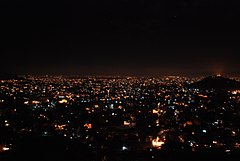| Tihar | |
|---|---|
 Night view of the Kathmandu city during the festival (2009) | |
| Also called | Bhai Tika, Deepawali, Yamapanchak |
| Type | spiritual |
| Celebrations | Decorating homes with lights, gathering, worshipping, singing and dancing (Deusi Bhailo), gambling, feasts |
| Observances | Prayers and religious rituals |
| Begins | Kārtika māsa kṛṣṇa pakṣa trayodashi tithi |
| Ends | Kārtika māsa śukla pakṣa dwitiya tithi |
| 2024 date | 30th October Wednesday, to 3rd November, Sunday |
| Frequency | Annual |
| Related to | Diwali, Diwali (Jainism), Bandi Chhor Divas, Swanti, Sohrai, Bandna |
Tihar (also known as Yamapanchak Deepawali) is a five-day spiritual and cultural Hindu festival of lights celebrated by Nepalese as well as by the Indian Gorkhas inhabiting Sikkim state and Territories (particularly the towns of Darjeeling and Kalimpong). Tihar is analogous to the Indian festival of Diwali, the festival of lights, but both are different Festival.
Tihar is referred to as Yamapanchak Tihar in Kathmandu Valley by Newari Nepalis and Dipawali Tihar in Madhesh Province by Madhesi Nepalis. In the rest of Nepal and the Indian states of Sikkim and Gorkhaland, both Nepalis and Indian Gorkhas refer to Diwali as the Tihar Parwa.
Like Diwali, it is marked by lighting diyo inside and outside the home, but unlike Diwali in other parts of India, the five days of Tihar include celebration and worship of the four creatures associated with the God of death Yama, with the final day reserved for people themselves.[1] According to the Vikram Samvat calendar, the festival begins with Kaag (crow) Tihar on Trayodashi tithi of Kārtika kṛṣṇa pakṣa (the 13th day of the waning moon) and ends with Bhai Tika on Dwitiya tithi of Kārtika śukla pakṣa every year.[2] In the Gregorian calendar, the festival falls sometime between October and November every year.[3]
- ^ Burbank, Jon, 1951– (January 2014). Nepal. ISBN 978-0-7614-8021-1. OCLC 1046067057.
{{cite book}}: CS1 maint: multiple names: authors list (link) CS1 maint: numeric names: authors list (link) - ^ "Kaag Tihar: When crow are worshiped". nepaltraveller.com. Retrieved 29 September 2020.
- ^ Nepal, Naturally. "Tihar". www.welcomenepal.com. Archived from the original on 13 June 2021. Retrieved 29 September 2020.